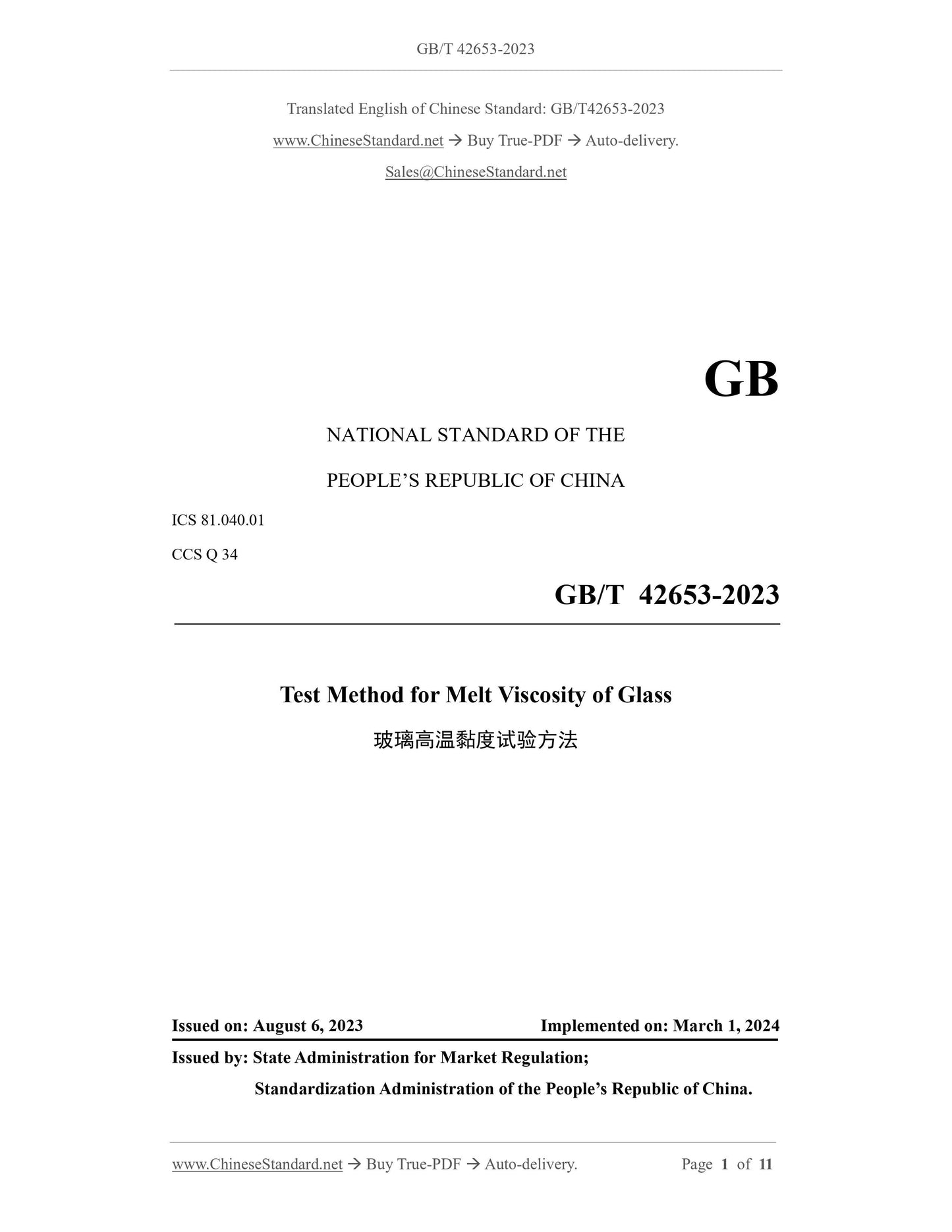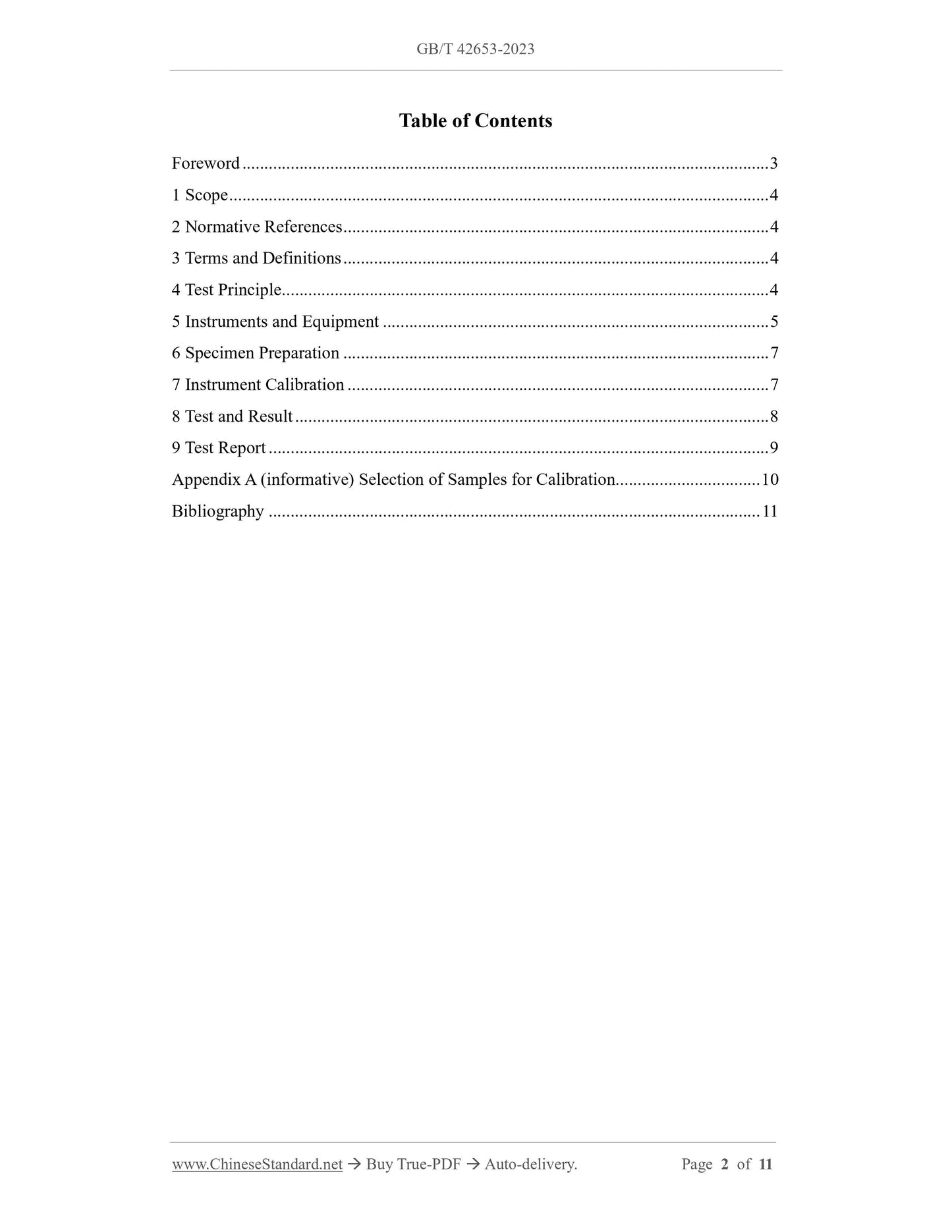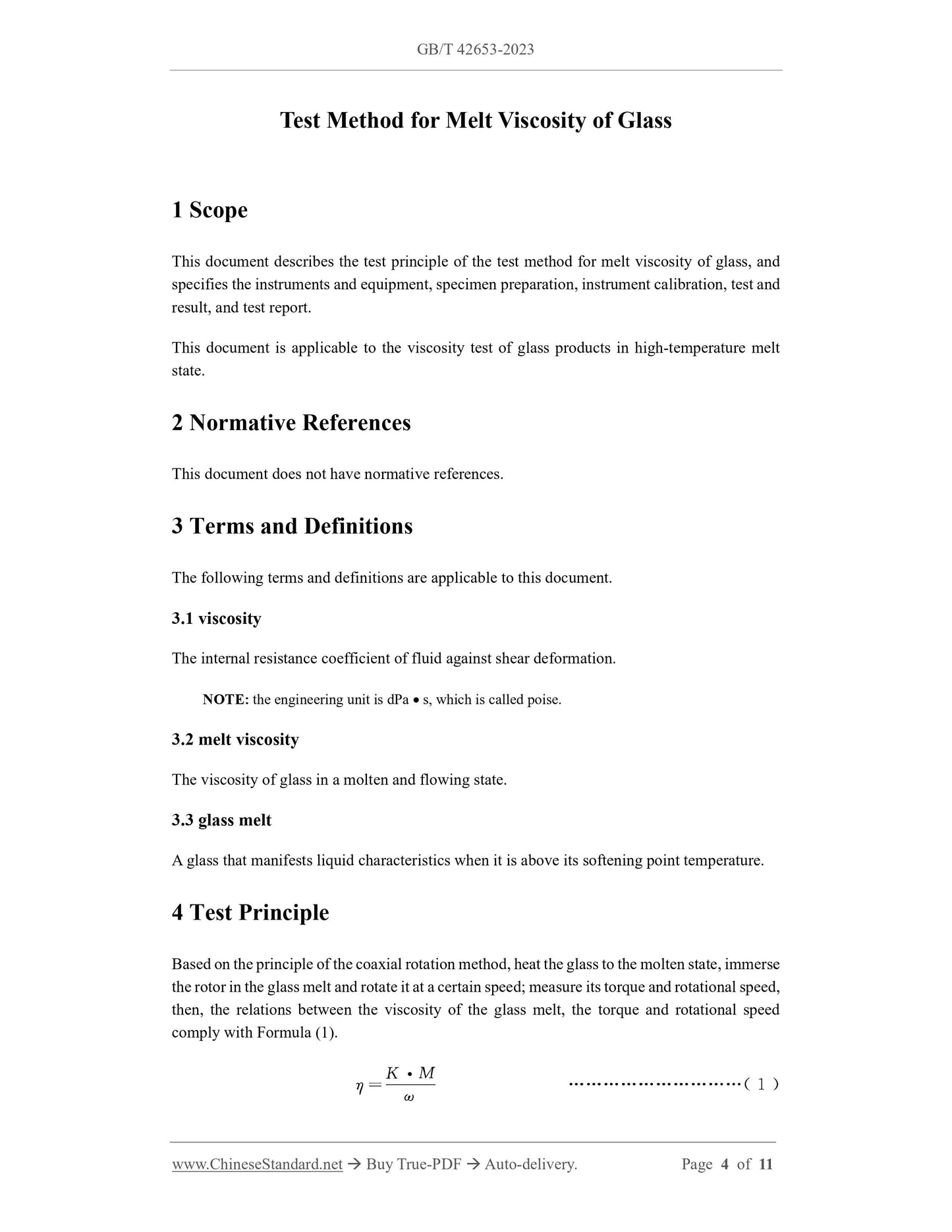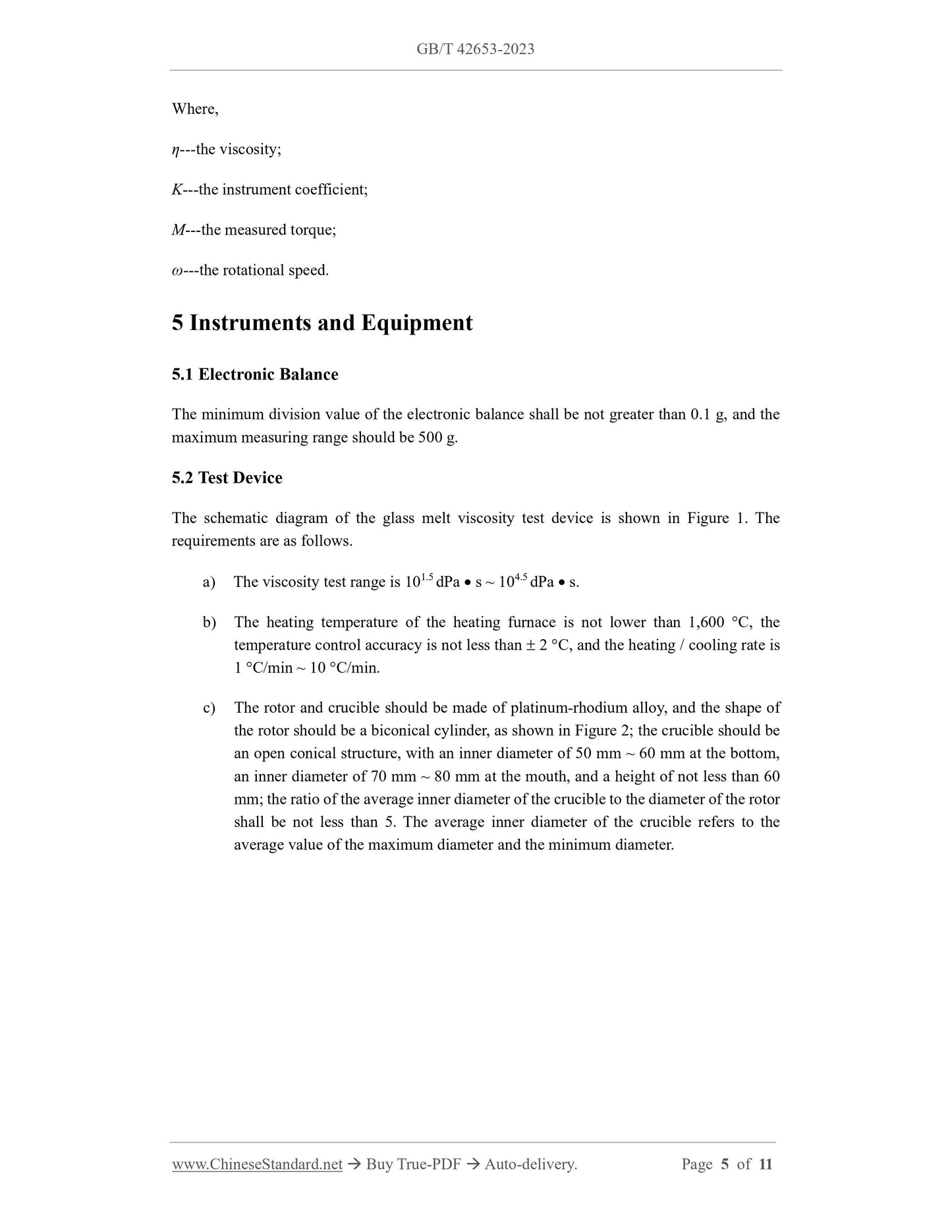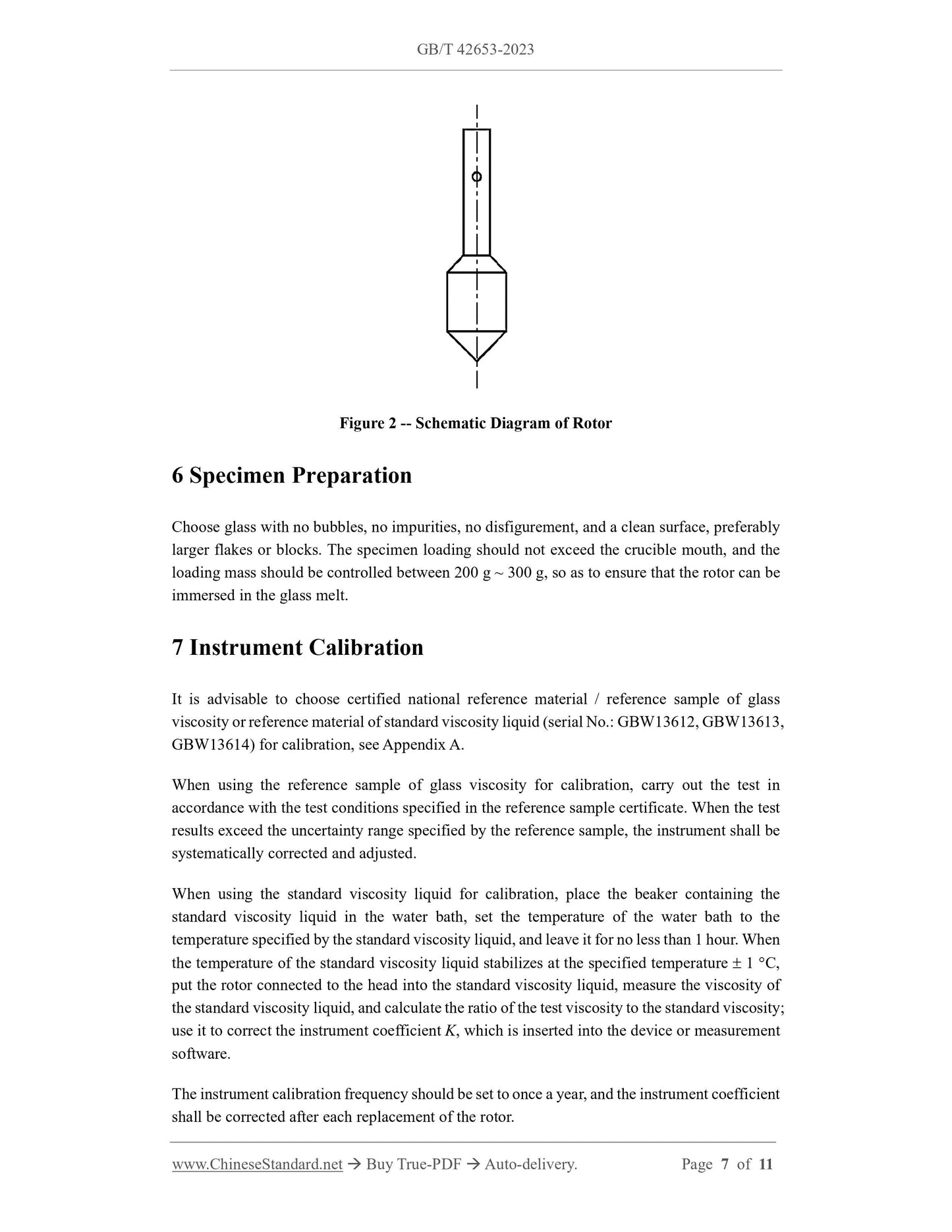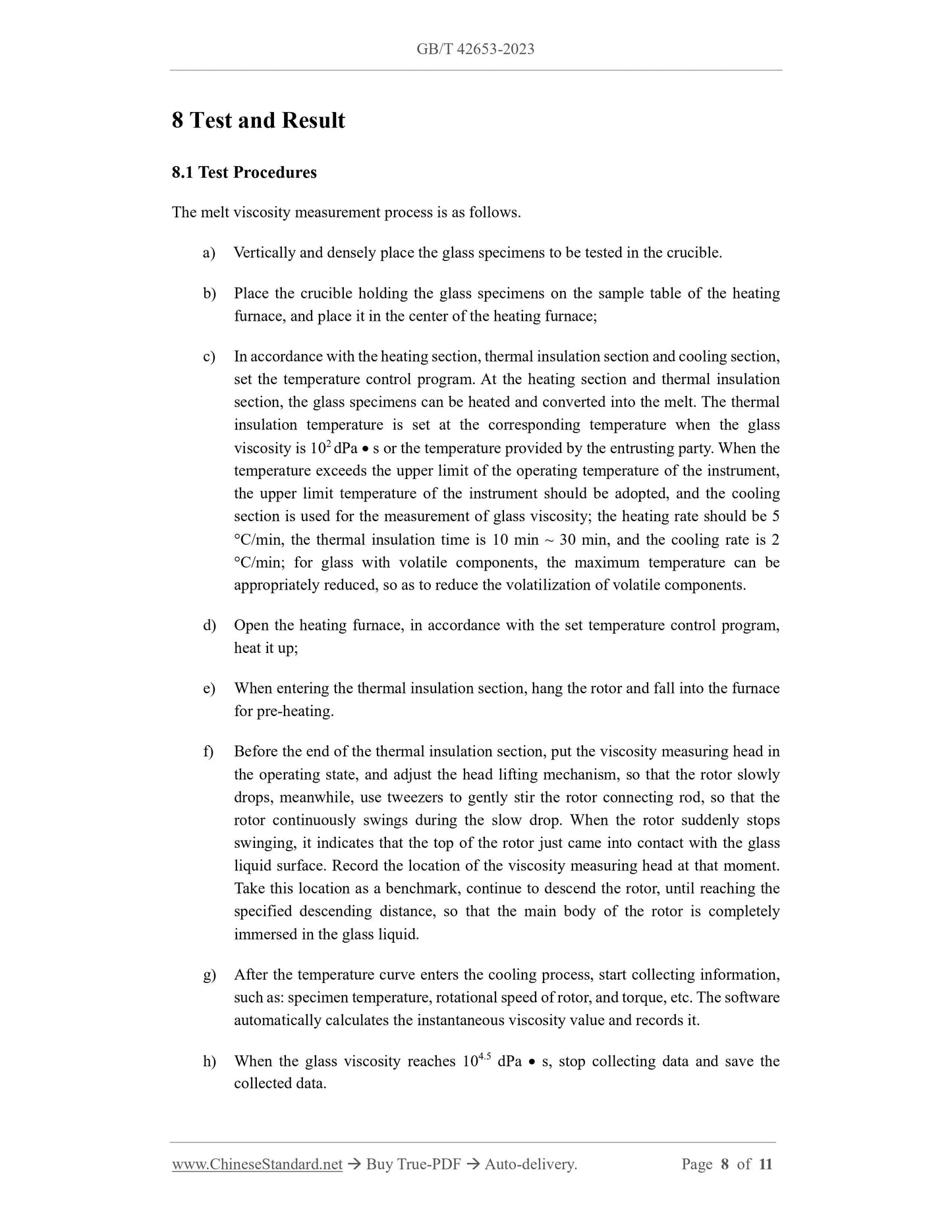1
/
of
6
PayPal, credit cards. Download editable-PDF and invoice in 1 second!
GB/T 42653-2023 English PDF (GBT42653-2023)
GB/T 42653-2023 English PDF (GBT42653-2023)
Regular price
$170.00 USD
Regular price
Sale price
$170.00 USD
Unit price
/
per
Shipping calculated at checkout.
Couldn't load pickup availability
Delivery: 3 seconds. Download true-PDF + Invoice.
Get QUOTATION in 1-minute: Click GB/T 42653-2023
Historical versions: GB/T 42653-2023
Preview True-PDF (Reload/Scroll if blank)
GB/T 42653-2023: Test method for melt viscosity of glass
GB/T 42653-2023
GB
NATIONAL STANDARD OF THE
PEOPLE’S REPUBLIC OF CHINA
ICS 81.040.01
CCS Q 34
Test Method for Melt Viscosity of Glass
ISSUED ON: AUGUST 6, 2023
IMPLEMENTED ON: MARCH 1, 2024
Issued by: State Administration for Market Regulation;
Standardization Administration of the People’s Republic of China.
Table of Contents
Foreword ... 3
1 Scope ... 4
2 Normative References ... 4
3 Terms and Definitions ... 4
4 Test Principle ... 4
5 Instruments and Equipment ... 5
6 Specimen Preparation ... 7
7 Instrument Calibration ... 7
8 Test and Result ... 8
9 Test Report ... 9
Appendix A (informative) Selection of Samples for Calibration ... 10
Bibliography ... 11
Test Method for Melt Viscosity of Glass
1 Scope
This document describes the test principle of the test method for melt viscosity of glass, and
specifies the instruments and equipment, specimen preparation, instrument calibration, test and
result, and test report.
This document is applicable to the viscosity test of glass products in high-temperature melt
state.
2 Normative References
This document does not have normative references.
3 Terms and Definitions
The following terms and definitions are applicable to this document.
3.1 viscosity
The internal resistance coefficient of fluid against shear deformation.
NOTE: the engineering unit is dPa s, which is called poise.
3.2 melt viscosity
The viscosity of glass in a molten and flowing state.
3.3 glass melt
A glass that manifests liquid characteristics when it is above its softening point temperature.
4 Test Principle
Based on the principle of the coaxial rotation method, heat the glass to the molten state, immerse
the rotor in the glass melt and rotate it at a certain speed; measure its torque and rotational speed,
then, the relations between the viscosity of the glass melt, the torque and rotational speed
comply with Formula (1).
Where,
η---the viscosity;
K---the instrument coefficient;
M---the measured torque;
ω---the rotational speed.
5 Instruments and Equipment
5.1 Electronic Balance
The minimum division value of the electronic balance shall be not greater than 0.1 g, and the
maximum measuring range should be 500 g.
5.2 Test Device
The schematic diagram of the glass melt viscosity test device is shown in Figure 1. The
requirements are as follows.
a) The viscosity test range is 101.5 dPa s ~ 104.5 dPa s.
b) The heating temperature of the heating furnace is not lower than 1,600 C, the
temperature control accuracy is not less than 2 C, and the heating / cooling rate is
1 C/min ~ 10 C/min.
c) The rotor and crucible should be made of platinum-rhodium alloy, and the shape of
the rotor should be a biconical cylinder, as shown in Figure 2; the crucible should be
an open conical structure, with an inner diameter of 50 mm ~ 60 mm at the bottom,
an inner diameter of 70 mm ~ 80 mm at the mouth, and a height of not less than 60
mm; the ratio of the average inner diameter of the crucible to the diameter of the rotor
shall be not less than 5. The average inner diameter of the crucible refers to the
average value of the maximum diameter and the minimum diameter.
Figure 2 -- Schematic Diagram of Rotor
6 Specimen Preparation
Choose glass with no bubbles, no impurities, no disfigurement, and a clean surface, preferably
larger flakes or blocks. The specimen loading should not exceed the crucible mouth, and the
loading mass should be controlled between 200 g ~ 300 g, so as to ensure that the rotor can be
immersed in the glass melt.
7 Instrument Calibration
It is advisable to choose certified national reference material / reference sample of glass
viscosity or reference material of standard viscosity liquid (serial No.: GBW13612, GBW13613,
GBW13614) for calibration, see Appendix A.
When using the reference sample of glass viscosity for calibration, carry out the test in
accordance with the test conditions specified in the reference sample certificate. When the test
results exceed the uncertainty range specified by the reference sample, the instrument shall be
systematically corrected and adjusted.
When using the standard viscosity liquid for calibration, place the beaker containing the
standard viscosity liquid in the water bath, set the temperature of the water bath to the
temperature specified by the standard viscosity liquid, and leave it for no less than 1 hour. When
the temperature of the standard viscosity liquid stabilizes at the specified temperature 1 C,
put the rotor connected to the head into the standard viscosity liquid, measure the viscosity of
the standard viscosity liquid, and calculate the ratio of the test viscosity to the standard viscosity;
use it to correct the instrument coefficient K, which is inserted into the device or measurement
software.
The instrument calibration frequency should be set to once a year, and the instrument coefficient
shall be corrected after each replacement of the rotor.
8 Test and Result
8.1 Test Procedures
The melt viscosity measurement process is as follows.
a) Vertically and densely place the glass specimens to be tested in the crucible.
b) Place the crucible holding the glass specimens on the sample table of the heating
furnace, and place it in the center of the heating furnace;
c) In accordance with the heating section, thermal insulation section and cooling section,
set the temperature control program. At the heating section and thermal insulation
section, the glass specimens can be heated and converted into the melt. The thermal
insulation temperature is set at the corresponding temperature when the glass
viscosity is 102 dPa s or the temperature provided by the entrusting party. When the
temperature exceeds the upper limit of the operating temperature of the instrument,
the upper limit temperature of the instrument should be adopted, and the cooling
section is used for the measurement of glass viscosity; the heating rate should be 5
C/min, the thermal insulation time is 10 min ~ 30 min, and the cooling rate is 2
C/min; for glass with volatile components, the maximum temperature can be
appropriately reduced, so as to reduce the volatilization of volatile components.
d) Open the heating furnace, in accordance with the set temperature control program,
heat it up;
e) When entering the thermal insulation section, hang the rotor and fall into the furnace
for pre-heating.
f) Before the end of the thermal insulation section, put the viscosity measuring head in
the operating state, and adjust the head lifting mechanism, so that the rotor slowly
drops, meanwhile, use tweezers to gently stir the rotor connecting rod, so that the
rotor continuously swings during the slow drop. When the rotor suddenly stops
swinging, it indicates that the top of the rotor just came into contact with the glass
liquid surface. Record the location of the viscosity measuring head at that moment.
Take this location as a benchmark, continue to descend the rotor, until reaching the
specified descending distance, so that the main body of the rotor is completely
immersed in the glass liquid.
g) After the temperature curve enters the cooling process, start collecting information,
such as: specimen temperature, rotational speed of rotor, and torque, etc. The software
automatically calculates the instantaneous viscosity value and records it.
h) When the glass viscosity reaches 104.5 dPa s, stop collecting dat...
Get QUOTATION in 1-minute: Click GB/T 42653-2023
Historical versions: GB/T 42653-2023
Preview True-PDF (Reload/Scroll if blank)
GB/T 42653-2023: Test method for melt viscosity of glass
GB/T 42653-2023
GB
NATIONAL STANDARD OF THE
PEOPLE’S REPUBLIC OF CHINA
ICS 81.040.01
CCS Q 34
Test Method for Melt Viscosity of Glass
ISSUED ON: AUGUST 6, 2023
IMPLEMENTED ON: MARCH 1, 2024
Issued by: State Administration for Market Regulation;
Standardization Administration of the People’s Republic of China.
Table of Contents
Foreword ... 3
1 Scope ... 4
2 Normative References ... 4
3 Terms and Definitions ... 4
4 Test Principle ... 4
5 Instruments and Equipment ... 5
6 Specimen Preparation ... 7
7 Instrument Calibration ... 7
8 Test and Result ... 8
9 Test Report ... 9
Appendix A (informative) Selection of Samples for Calibration ... 10
Bibliography ... 11
Test Method for Melt Viscosity of Glass
1 Scope
This document describes the test principle of the test method for melt viscosity of glass, and
specifies the instruments and equipment, specimen preparation, instrument calibration, test and
result, and test report.
This document is applicable to the viscosity test of glass products in high-temperature melt
state.
2 Normative References
This document does not have normative references.
3 Terms and Definitions
The following terms and definitions are applicable to this document.
3.1 viscosity
The internal resistance coefficient of fluid against shear deformation.
NOTE: the engineering unit is dPa s, which is called poise.
3.2 melt viscosity
The viscosity of glass in a molten and flowing state.
3.3 glass melt
A glass that manifests liquid characteristics when it is above its softening point temperature.
4 Test Principle
Based on the principle of the coaxial rotation method, heat the glass to the molten state, immerse
the rotor in the glass melt and rotate it at a certain speed; measure its torque and rotational speed,
then, the relations between the viscosity of the glass melt, the torque and rotational speed
comply with Formula (1).
Where,
η---the viscosity;
K---the instrument coefficient;
M---the measured torque;
ω---the rotational speed.
5 Instruments and Equipment
5.1 Electronic Balance
The minimum division value of the electronic balance shall be not greater than 0.1 g, and the
maximum measuring range should be 500 g.
5.2 Test Device
The schematic diagram of the glass melt viscosity test device is shown in Figure 1. The
requirements are as follows.
a) The viscosity test range is 101.5 dPa s ~ 104.5 dPa s.
b) The heating temperature of the heating furnace is not lower than 1,600 C, the
temperature control accuracy is not less than 2 C, and the heating / cooling rate is
1 C/min ~ 10 C/min.
c) The rotor and crucible should be made of platinum-rhodium alloy, and the shape of
the rotor should be a biconical cylinder, as shown in Figure 2; the crucible should be
an open conical structure, with an inner diameter of 50 mm ~ 60 mm at the bottom,
an inner diameter of 70 mm ~ 80 mm at the mouth, and a height of not less than 60
mm; the ratio of the average inner diameter of the crucible to the diameter of the rotor
shall be not less than 5. The average inner diameter of the crucible refers to the
average value of the maximum diameter and the minimum diameter.
Figure 2 -- Schematic Diagram of Rotor
6 Specimen Preparation
Choose glass with no bubbles, no impurities, no disfigurement, and a clean surface, preferably
larger flakes or blocks. The specimen loading should not exceed the crucible mouth, and the
loading mass should be controlled between 200 g ~ 300 g, so as to ensure that the rotor can be
immersed in the glass melt.
7 Instrument Calibration
It is advisable to choose certified national reference material / reference sample of glass
viscosity or reference material of standard viscosity liquid (serial No.: GBW13612, GBW13613,
GBW13614) for calibration, see Appendix A.
When using the reference sample of glass viscosity for calibration, carry out the test in
accordance with the test conditions specified in the reference sample certificate. When the test
results exceed the uncertainty range specified by the reference sample, the instrument shall be
systematically corrected and adjusted.
When using the standard viscosity liquid for calibration, place the beaker containing the
standard viscosity liquid in the water bath, set the temperature of the water bath to the
temperature specified by the standard viscosity liquid, and leave it for no less than 1 hour. When
the temperature of the standard viscosity liquid stabilizes at the specified temperature 1 C,
put the rotor connected to the head into the standard viscosity liquid, measure the viscosity of
the standard viscosity liquid, and calculate the ratio of the test viscosity to the standard viscosity;
use it to correct the instrument coefficient K, which is inserted into the device or measurement
software.
The instrument calibration frequency should be set to once a year, and the instrument coefficient
shall be corrected after each replacement of the rotor.
8 Test and Result
8.1 Test Procedures
The melt viscosity measurement process is as follows.
a) Vertically and densely place the glass specimens to be tested in the crucible.
b) Place the crucible holding the glass specimens on the sample table of the heating
furnace, and place it in the center of the heating furnace;
c) In accordance with the heating section, thermal insulation section and cooling section,
set the temperature control program. At the heating section and thermal insulation
section, the glass specimens can be heated and converted into the melt. The thermal
insulation temperature is set at the corresponding temperature when the glass
viscosity is 102 dPa s or the temperature provided by the entrusting party. When the
temperature exceeds the upper limit of the operating temperature of the instrument,
the upper limit temperature of the instrument should be adopted, and the cooling
section is used for the measurement of glass viscosity; the heating rate should be 5
C/min, the thermal insulation time is 10 min ~ 30 min, and the cooling rate is 2
C/min; for glass with volatile components, the maximum temperature can be
appropriately reduced, so as to reduce the volatilization of volatile components.
d) Open the heating furnace, in accordance with the set temperature control program,
heat it up;
e) When entering the thermal insulation section, hang the rotor and fall into the furnace
for pre-heating.
f) Before the end of the thermal insulation section, put the viscosity measuring head in
the operating state, and adjust the head lifting mechanism, so that the rotor slowly
drops, meanwhile, use tweezers to gently stir the rotor connecting rod, so that the
rotor continuously swings during the slow drop. When the rotor suddenly stops
swinging, it indicates that the top of the rotor just came into contact with the glass
liquid surface. Record the location of the viscosity measuring head at that moment.
Take this location as a benchmark, continue to descend the rotor, until reaching the
specified descending distance, so that the main body of the rotor is completely
immersed in the glass liquid.
g) After the temperature curve enters the cooling process, start collecting information,
such as: specimen temperature, rotational speed of rotor, and torque, etc. The software
automatically calculates the instantaneous viscosity value and records it.
h) When the glass viscosity reaches 104.5 dPa s, stop collecting dat...
Share
